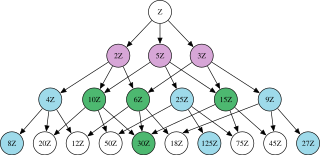
In mathematics, rings are algebraic structures that generalize fields: multiplication need not be commutative and multiplicative inverses need not exist. In other words, a ring is a set equipped with two binary operations satisfying properties analogous to those of addition and multiplication of integers. Ring elements may be numbers such as integers or complex numbers, but they may also be non-numerical objects such as polynomials, square matrices, functions, and power series.
In mathematics, more specifically ring theory, the Jacobson radical of a ring is the ideal consisting of those elements in that annihilate all simple right -modules. It happens that substituting "left" in place of "right" in the definition yields the same ideal, and so the notion is left-right symmetric. The Jacobson radical of a ring is frequently denoted by or ; the former notation will be preferred in this article, because it avoids confusion with other radicals of a ring. The Jacobson radical is named after Nathan Jacobson, who was the first to study it for arbitrary rings in.
Ring theory is the branch of mathematics in which rings are studied: that is, structures supporting both an addition and a multiplication operation. This is a glossary of some terms of the subject.
In algebra, the Wedderburn–Artin theorem is a classification theorem for semisimple rings and semisimple algebras. The theorem states that an (Artinian) semisimple ring R is isomorphic to a product of finitely many ni-by-ni matrix rings over division rings Di, for some integers ni, both of which are uniquely determined up to permutation of the index i. In particular, any simple left or right Artinian ring is isomorphic to an n-by-n matrix ring over a division ring D, where both n and D are uniquely determined.
In abstract algebra, a branch of mathematics, a simple ring is a non-zero ring that has no two-sided ideal besides the zero ideal and itself. In particular, a commutative ring is a simple ring if and only if it is a field.
In the branch of abstract algebra known as ring theory, a left primitive ring is a ring which has a faithful simple left module. Well known examples include endomorphism rings of vector spaces and Weyl algebras over fields of characteristic zero.
In abstract algebra, a nonzero ring R is a prime ring if for any two elements a and b of R, arb = 0 for all r in R implies that either a = 0 or b = 0. This definition can be regarded as a simultaneous generalization of both integral domains and simple rings.
In abstract algebra, a matrix ring is a set of matrices with entries in a ring R that form a ring under matrix addition and matrix multiplication. The set of all n × n matrices with entries in R is a matrix ring denoted Mn(R). Some sets of infinite matrices form infinite matrix rings. Any subring of a matrix ring is a matrix ring. Over a rng, one can form matrix rngs.
In mathematics, especially in the area of abstract algebra known as module theory, a semisimple module or completely reducible module is a type of module that can be understood easily from its parts. A ring that is a semisimple module over itself is known as an Artinian semisimple ring. Some important rings, such as group rings of finite groups over fields of characteristic zero, are semisimple rings. An Artinian ring is initially understood via its largest semisimple quotient. The structure of Artinian semisimple rings is well understood by the Artin–Wedderburn theorem, which exhibits these rings as finite direct products of matrix rings.
In abstract algebra, Morita equivalence is a relationship defined between rings that preserves many ring-theoretic properties. More precisely two rings like R, S are Morita equivalent if their categories of modules are additively equivalent. It is named after Japanese mathematician Kiiti Morita who defined equivalence and a similar notion of duality in 1958.
In mathematics, the term socle has several related meanings.
In ring theory, a branch of mathematics, a semisimple algebra is an associative artinian algebra over a field which has trivial Jacobson radical. If the algebra is finite-dimensional this is equivalent to saying that it can be expressed as a Cartesian product of simple subalgebras.

In ring theory, a branch of mathematics, semiprime ideals and semiprime rings are generalizations of prime ideals and prime rings. In commutative algebra, semiprime ideals are also called radical ideals and semiprime rings are the same as reduced rings.
In abstract algebra, an associated prime of a module M over a ring R is a type of prime ideal of R that arises as an annihilator of a (prime) submodule of M. The set of associated primes is usually denoted by and sometimes called the assassin or assassinator of M.
In the area of abstract algebra known as ring theory, a left perfect ring is a type of ring in which all left modules have projective covers. The right case is defined by analogy, and the condition is not left-right symmetric; that is, there exist rings which are perfect on one side but not the other. Perfect rings were introduced in Bass's book.

In mathematics, more specifically abstract algebra and ring theory, a noncommutative ring is a ring whose multiplication is not required to be commutative; that is, there may exist a and b in R with a·b ≠ b·a. These include commutative rings as a subclass. Noncommutative algebra is the study of results applying to rings that are not required to be commutative. Many important results in the field of noncommutative algebra apply to commutative rings as special cases. Some authors use the term noncommutative ring to refer to a ring that is strictly noncommutative, that is, for which there do exist a and b in R with a·b ≠ b·a.
In mathematics, especially ring theory, the class of Frobenius rings and their generalizations are the extension of work done on Frobenius algebras. Perhaps the most important generalization is that of quasi-Frobenius rings, which are in turn generalized by right pseudo-Frobenius rings and right finitely pseudo-Frobenius rings. Other diverse generalizations of quasi-Frobenius rings include QF-1, QF-2 and QF-3 rings.
In ring theory, a subfield of abstract algebra, a right Kasch ring is a ring R for which every simple right R module is isomorphic to a right ideal of R. Analogously the notion of a left Kasch ring is defined, and the two properties are independent of each other.
In the branch of abstract algebra known as ring theory, a minimal right ideal of a ring R is a nonzero right ideal which contains no other nonzero right ideal. Likewise, a minimal left ideal is a nonzero left ideal of R containing no other nonzero left ideals of R, and a minimal ideal of R is a nonzero ideal containing no other nonzero two-sided ideal of R.
In mathematics, semi-simplicity is a widespread concept in disciplines such as linear algebra, abstract algebra, representation theory, category theory, and algebraic geometry. A semi-simple object is one that can be decomposed into a sum of simple objects, and simple objects are those that do not contain non-trivial proper sub-objects. The precise definitions of these words depends on the context.













